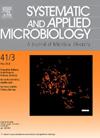Identification and functional genomic analyses of Bartonella isolates from honey bees, and reassessment of the taxonomy of the genus Bartonella
IF 4.2
2区 生物学
Q2 BIOTECHNOLOGY & APPLIED MICROBIOLOGY
引用次数: 0
Abstract
We used matrix-assisted laser desorption/ionization time-of-flight mass spectrometry and whole-genome sequence analyses to identify 90 Bartonella isolates from honey bee gut samples in Belgium. While the identification of 62 isolates as Bartonella apihabitans and three as Bartonella choladocola was straightforward, the identification of 25 Bartonella apis-like isolates was challenging. A taxonomic and functional analysis of four B. apis-like genomes and of publicly available B. apis genomes demonstrated that neither OrthoANIu and digital DNA-DNA hybridization analyses, nor functional annotation supported a clear separation of B. apis and B. apis-like genomes. Different phylogenomic analyses showed that B. apis and B. apis-like strains formed a monophyletic clade with an inconsistent internal structure. We therefore considered the remaining 25 isolates identified as B. apis. We subsequently re-addressed an earlier phylogenetic and functional divergence between three major clades of Bartonella species which differed not only in phylogenomic position and ecology, but also in genome size and genomic percentage G + C content, and in many metabolic capabilities. We propose to reclassify the single species of the Bartonella tamiae clade into the novel genus Attibartonella gen. nov., with Attibartonella tamiae comb. nov. as the type species. Similarly, we propose to reclassify species of the honey bee-associated Bartonella clade into the novel genus Ditibartonella gen. nov., with Ditibartonella apis comb. nov. as the type species. The phylogenomic analyses of publicly available genome and metagenome sequences revealed additional Ditibartonella species in honey bee samples, highlighted an evolutionary adaptation of Ditibartonella bacteria to bee hosts and suggested shared transmission routes.
蜜蜂巴尔通体分离株的鉴定和功能基因组分析,以及巴尔通体属分类的重新评估
采用基质辅助激光解吸/电离飞行时间质谱法和全基因组序列分析对比利时蜜蜂肠道样本中的90株巴尔通体分离株进行了鉴定。62株蜜蜂巴尔通体和3株choladocola巴尔通体的鉴定比较简单,而25株类似蜜蜂巴尔通体的鉴定则比较困难。对4个类人猿基因组和已公开的类人猿基因组的分类和功能分析表明,OrthoANIu和数字DNA-DNA杂交分析以及功能注释都不支持类人猿和类人猿基因组的明确分离。不同的系统发育分析表明,apis apis和apis apis apis样菌株形成了一个内部结构不一致的单系分支。因此,我们认为剩余的25株分离株为白僵菌。随后,我们重新研究了巴尔通体三个主要分支之间的早期系统发育和功能差异,这些差异不仅在系统发育位置和生态上存在差异,而且在基因组大小和基因组百分比G + C含量以及许多代谢能力上也存在差异。我们建议将tamiae巴尔通体分支的单一种重新分类为新属Attibartonella gen. nov.,并使用Attibartonella tamiae梳子。11月为模式种。同样,我们建议将与蜜蜂相关的巴尔通体分支重新分类为新属Ditibartonella gen. nov.,并使用蜜蜂双巴尔通体梳子。11月为模式种。对公开获得的基因组和元基因组序列的系统基因组学分析显示,蜜蜂样本中存在其他双提巴尔通体物种,突出了双提巴尔通体细菌对蜜蜂宿主的进化适应,并提出了共享的传播途径。
本文章由计算机程序翻译,如有差异,请以英文原文为准。
求助全文
约1分钟内获得全文
求助全文
来源期刊

Systematic and applied microbiology
生物-生物工程与应用微生物
CiteScore
7.50
自引率
5.90%
发文量
57
审稿时长
22 days
期刊介绍:
Systematic and Applied Microbiology deals with various aspects of microbial diversity and systematics of prokaryotes. It focuses on Bacteria and Archaea; eukaryotic microorganisms will only be considered in rare cases. The journal perceives a broad understanding of microbial diversity and encourages the submission of manuscripts from the following branches of microbiology:
 求助内容:
求助内容: 应助结果提醒方式:
应助结果提醒方式:


